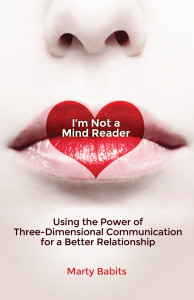Praise for I’m Not a Mind Reader by Marty Babits
“Talking through an issue with a partner sounds simple, but it can be deceptively difficult. Too often we’re talking at, talking around or talking down. In I’m Not a Mind Reader, Marty Babits provides couples with the tools to deconstruct their approach to communication via three clear dimensions and then reconstruct in a manner that emphasizes compassion, emotional safety and a sense of togetherness. With realistic case studies, quizzes, diagnostics and sample scripts, the net effect of Babits’ three dimensional communication is that we gain the power and mindfulness to talk ‘through’ any situation, big or small, and get to the other side with love, respect and and equanimity. Written with warmth and compassion, this book is required reading for any couple who has stared deep into the eyes of their beloved and longed for the words to match, even expand upon, the feeling.”
— Ian Kerner, PhD, MFT, NY Times best-selling author of She Comes First.
“I’m Not a Mind Reader: Using the Power of Three-Dimensional Communication to Make a Better Relationship is that rare combination of brilliance and practicality. Marty Babits’ uses both intersubjectivity and the neurobiology of attachment as perspectives that inform his clinical work with couples. This approach is exceptionally insightful and innovative; moreover, his case material makes clear how the theoretical concepts manifest themselves in the actual words and actions of both the couple and therapist. Especially useful to the clinician is the specific language the author uses to help his clients understand the ways in which they are attuned (or not) to their partners on the three levels of communication.”
–Rosemary Masters, J.D., LCSW, Founding Director of the Trauma Study Center of ICP
“First comes love…then comes Babits….then comes marriage and the baby carriage! This book should be required reading for all beginning couples.”
–Suzanne Iasenza, PhD, renown psychologist/sex therapist currently practicing in Manhattan. She is Faculty at the Institute for Contemporary Psychotherapy and Psychoanalysis and the Postgraduate Program in Couples and Family Therapy of Adelphi University’s Derner Institute.
“Marty Babits’ skill at rendering dialogue is novelistic, and only as the reader begins to absorb the sincerity with which the couples and their therapist struggle with constraints, conscious or not, does the real strength of our human need for attachment appear. From written exercises to sexuality to the section on Neuroscience, chapter after chapter of candid writing— unique in any book on empowerment—are bold, frank, empathic and useful.”
–Elizabeth Danto, PhD, professor of social work, emeritus, Hunter College – City University of New York, author of Freud’s Free Clinics (Columbia University Press, 2007)
“Marty Babits has written another excellent book to help both couples and their therapists. I appreciate his addressing of neuroscience to illustrate a goal of treatment: using more logical reasoning (via the cerebral cortex) to better control the emotions (via the amygdala) that interfere with optimal communication.”
–Jeffrey B. Freedman, MD, Director, Division of Psychosomatic Medicine, Mount Sinai Roosevelt and St. Luke’s Hospitals, New York, NY
 I’m Not a Mind Reader by Marty Babits is a must read for anyone in a long term relationship! Even couples who feel they have a strong partnership can benefit from the strategies taught in this book. Communication is key and Babits lays out a simplistic yet powerful 3 dimensional formula that really makes sense! Highly recommend to anyone looking to strengthen their relationship or needing the tools to improve it.
I’m Not a Mind Reader by Marty Babits is a must read for anyone in a long term relationship! Even couples who feel they have a strong partnership can benefit from the strategies taught in this book. Communication is key and Babits lays out a simplistic yet powerful 3 dimensional formula that really makes sense! Highly recommend to anyone looking to strengthen their relationship or needing the tools to improve it.